2022年中考英语副词精讲课件34张
文档属性
| 名称 | 2022年中考英语副词精讲课件34张 | 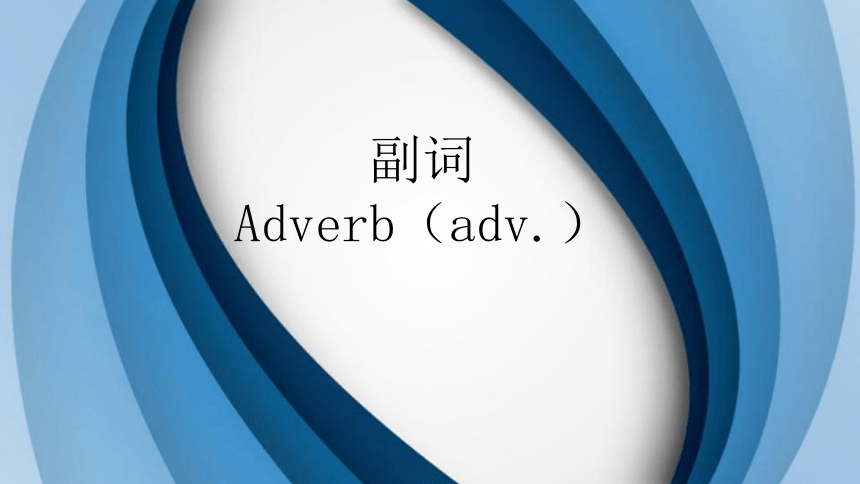 | |
| 格式 | pptx | ||
| 文件大小 | 338.4KB | ||
| 资源类型 | 教案 | ||
| 版本资源 | 通用版 | ||
| 科目 | 英语 | ||
| 更新时间 | 2022-04-11 16:26:33 | ||
图片预览

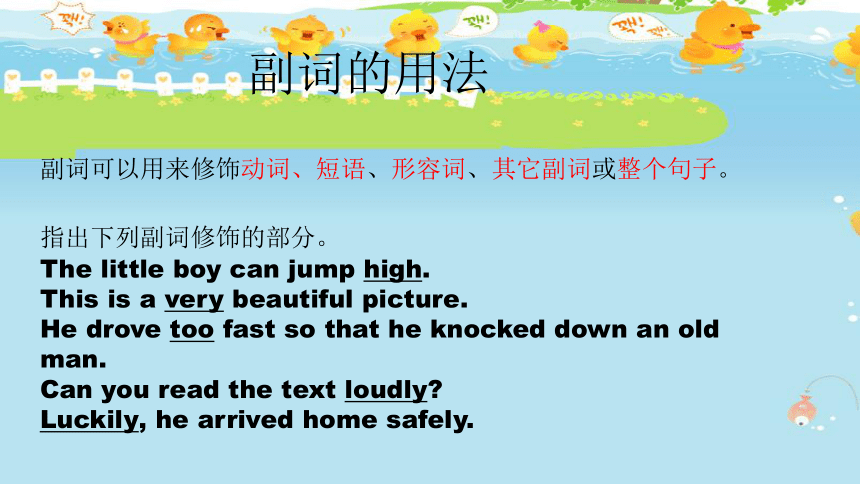
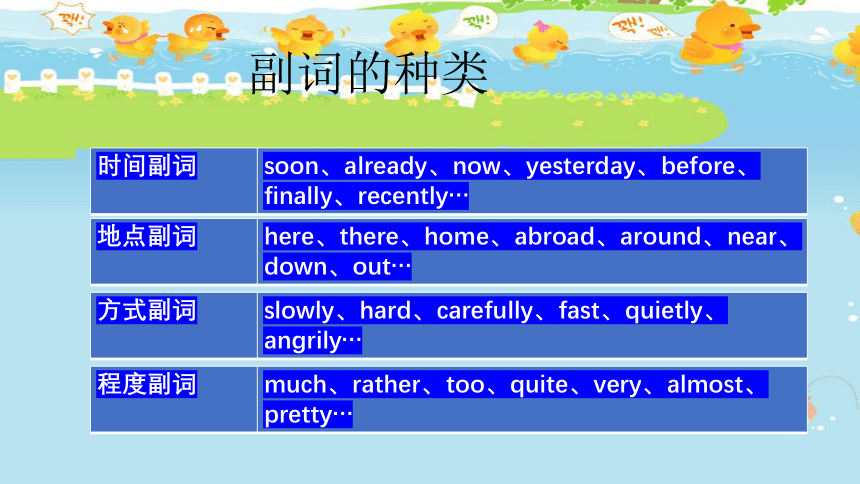
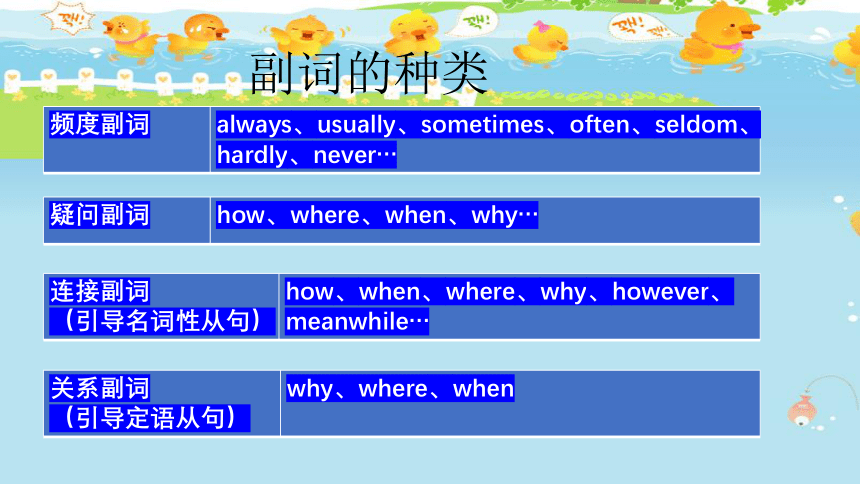
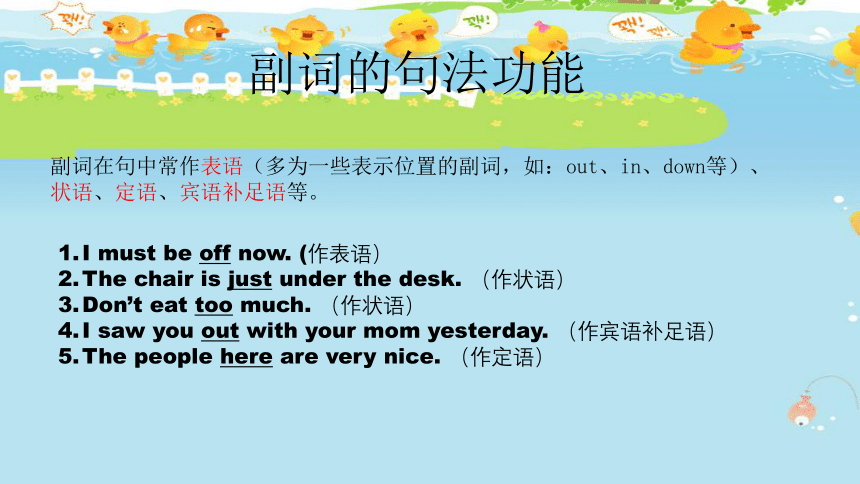
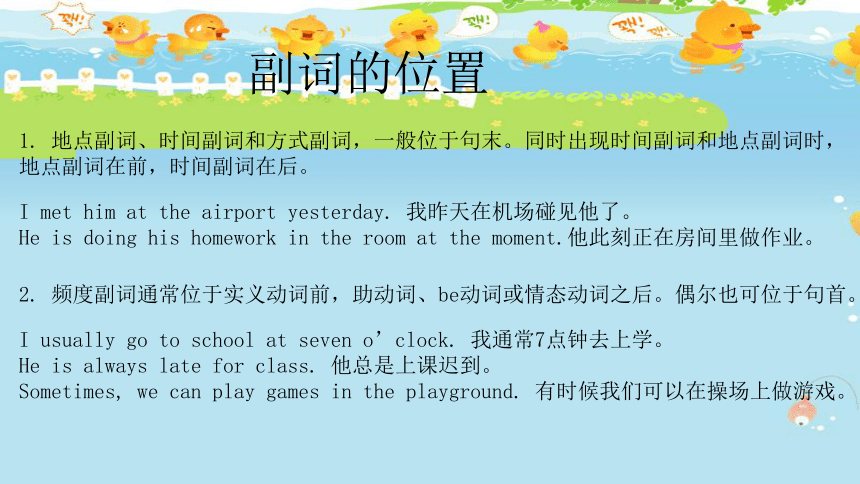
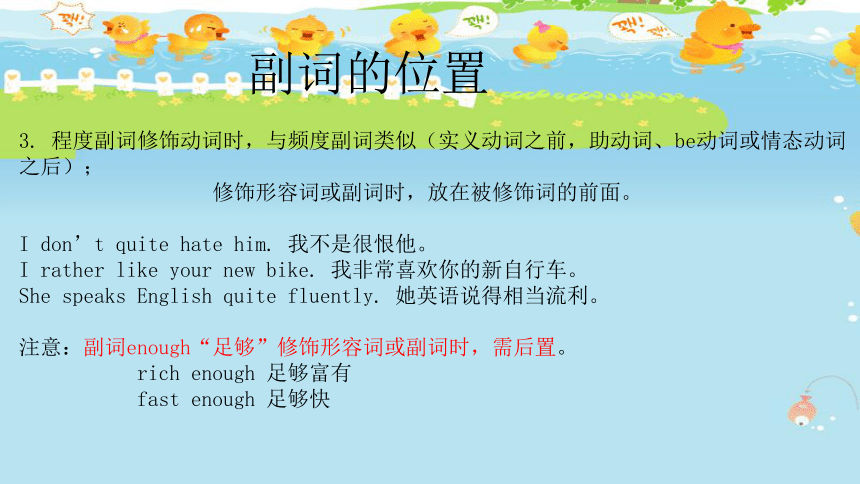
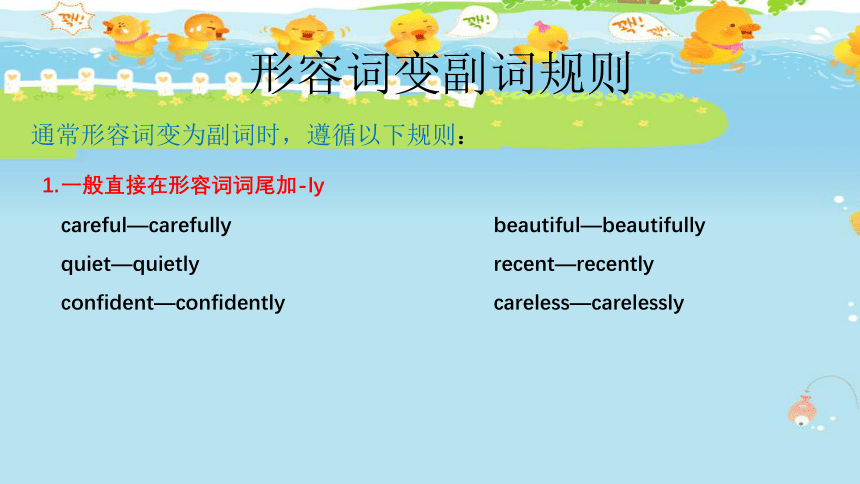
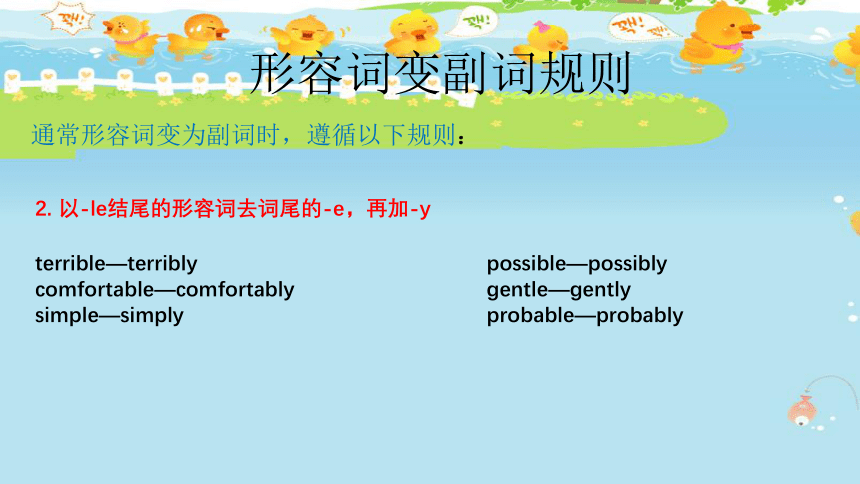
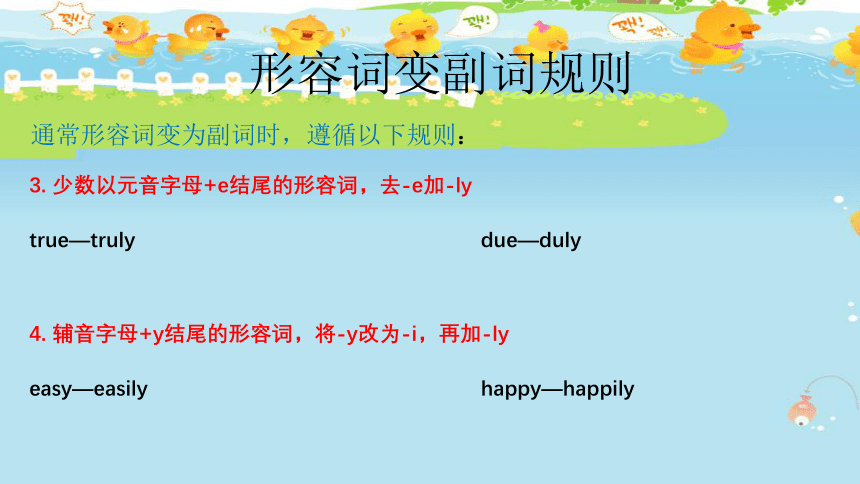
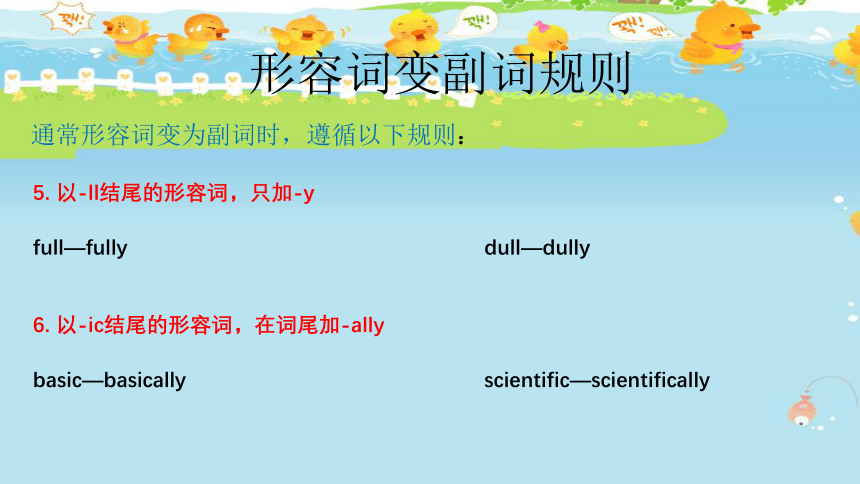
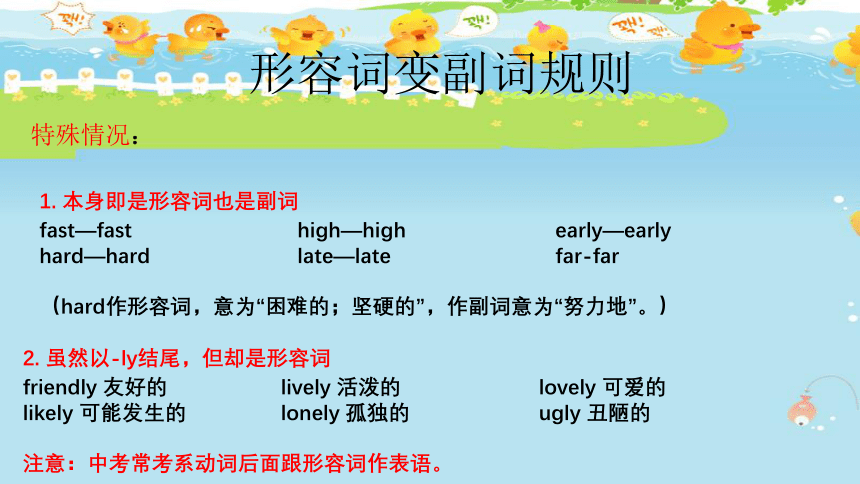
文档简介
(共34张PPT)
副词
Adverb(adv.)
副词的用法
副词可以用来修饰动词、短语、形容词、其它副词或整个句子。
指出下列副词修饰的部分。
The little boy can jump high.
This is a very beautiful picture.
He drove too fast so that he knocked down an old man.
Can you read the text loudly
Luckily, he arrived home safely.
副词的种类
时间副词 soon、already、now、yesterday、before、finally、recently…
地点副词 here、there、home、abroad、around、near、down、out…
方式副词 slowly、hard、carefully、fast、quietly、angrily…
程度副词 much、rather、too、quite、very、almost、pretty…
副词的种类
频度副词 always、usually、sometimes、often、seldom、hardly、never…
疑问副词 how、where、when、why…
连接副词
(引导名词性从句) how、when、where、why、however、meanwhile…
关系副词 (引导定语从句) why、where、when
副词的句法功能
副词在句中常作表语(多为一些表示位置的副词,如:out、in、down等)、状语、定语、宾语补足语等。
I must be off now. (作表语)
The chair is just under the desk. (作状语)
Don’t eat too much. (作状语)
I saw you out with your mom yesterday. (作宾语补足语)
The people here are very nice. (作定语)
副词的位置
1. 地点副词、时间副词和方式副词,一般位于句末。同时出现时间副词和地点副词时,地点副词在前,时间副词在后。
I met him at the airport yesterday. 我昨天在机场碰见他了。
He is doing his homework in the room at the moment.他此刻正在房间里做作业。
2. 频度副词通常位于实义动词前,助动词、be动词或情态动词之后。偶尔也可位于句首。
I usually go to school at seven o’clock. 我通常7点钟去上学。
He is always late for class. 他总是上课迟到。
Sometimes, we can play games in the playground. 有时候我们可以在操场上做游戏。
副词的位置
3. 程度副词修饰动词时,与频度副词类似(实义动词之前,助动词、be动词或情态动词之后);
修饰形容词或副词时,放在被修饰词的前面。
I don’t quite hate him. 我不是很恨他。
I rather like your new bike. 我非常喜欢你的新自行车。
She speaks English quite fluently. 她英语说得相当流利。
注意:副词enough“足够”修饰形容词或副词时,需后置。
rich enough 足够富有
fast enough 足够快
形容词变副词规则
通常形容词变为副词时,遵循以下规则:
一般直接在形容词词尾加-ly
careful—carefully beautiful—beautifully
quiet—quietly recent—recently
confident—confidently careless—carelessly
形容词变副词规则
通常形容词变为副词时,遵循以下规则:
2. 以-le结尾的形容词去词尾的-e,再加-y
terrible—terribly possible—possibly
comfortable—comfortably gentle—gently
simple—simply probable—probably
形容词变副词规则
通常形容词变为副词时,遵循以下规则:
3. 少数以元音字母+e结尾的形容词,去-e加-ly
true—truly due—duly
4. 辅音字母+y结尾的形容词,将-y改为-i,再加-ly
easy—easily happy—happily
形容词变副词规则
通常形容词变为副词时,遵循以下规则:
5. 以-ll结尾的形容词,只加-y
full—fully dull—dully
6. 以-ic结尾的形容词,在词尾加-ally
basic—basically scientific—scientifically
形容词变副词规则
特殊情况:
1. 本身即是形容词也是副词
fast—fast high—high early—early
hard—hard late—late far-far
(hard作形容词,意为“困难的;坚硬的”,作副词意为“努力地”。)
2. 虽然以-ly结尾,但却是形容词
friendly 友好的 lively 活泼的 lovely 可爱的
likely 可能发生的 lonely 孤独的 ugly 丑陋的
注意:中考常考系动词后面跟形容词作表语。
副词的原级比较
原级比较句型:as + adv.原级 + as… 像……一样……
翻译下列句子。
这条狗狗和那条狗跑得一样快。
她的英文写得和她哥哥一样好。
This dog runs as fast as that one.
She writes English as well as her brother.
否定形式:not as/so + adv.原级 + as…
This dog doesn’t run as/so fast as that one.
同义句:This dog runs less fast than that one. (less…than…不如……)比较级句型
Adj./Adv.的比较级最高级变化规则
规则变化:
1.单音节的词直接在词尾加-er/-est,
hard—harder—hardest;fast —faster —fastest
2.以字母-e结尾的单音节词在其后面直接加-r/-st
brave—braver—bravest;
3. 以一个辅音字母结尾的重读闭音节,先双写这个辅音字母再加-er/-est
big—bigger—biggest;hot—hotter—hottest
Adj./Adv.的比较级最高级变化规则
规则变化:
4. 以辅音字母+y结尾的双音节词,先把-y改为-i,再加-er/-est。
happy—happier—happiest;heavy—heavier—heaviest;
early—earlier—earliest
5. 其它双音节词和多音节词,在前面加more和most
Beautiful—more beautiful—most beautiful;
slowly—more slowly—most slowly
Adj./Adv.的比较级最高级变化规则
不规则变化:
good/well—better—best bad/ill/badly—worse—worst
many/much—more—most little—less—least
far—farther—farthest
Adj./Adv.
副词的比较级
表示两者之间进行比较,标志词than。
He studies much harder than I (do). 他比我努力地多。
My car can runs faster than yours. 我的小汽车比你的跑得快。
注意:
比较需是同类事物之间进行。
常用修饰比较级的副词:much;rather;even、far、a little、a bit、still等。
副词的比较级
特殊结构:
比较级+and+比较级 表示“越来越……”
The car runs faster and faster. 小汽车跑得越来越快。
The balloons fly higher and higher. 风筝飞得越来越高。
She will certainly skate more and more beautifully.
她一定会滑得越来越漂亮。
2. the+比较级…, the+比较级…表示“越……就越……”
The more carefully you listen, the better you understand.你听得越仔细,你理解得就越好。
The more you know, the better you work. 你知道的越多,工作就越好。
副词的最高级
表示三者及以上范围内之最: (the)+副词最高级+范围(in/of/among…)
(副词最高级前的定冠词the可省略)
He swam (the) fastest in his class. 他是班里游得最快的。
She likes English best of all. 她最喜欢英语。
副词的最高级
比较级句型与最高级进行同义句替换:
Tom is the tallest student in our class. (同义句替换)
Tom is taller than ________ ________ ________ in our class.
Tom is taller than ________ ________ ________ in our class.
any other student
the other students
比较级句型表示最高级意义:
比较级+than any other +单数名词
比较级+than the other+名词复数
= the+最高级+范围
注意:当不在同一个范围时,用比较级+than any+单数名词
The girl in her class comes to school earlier than any students in our class.
她班上的那个女孩比我们班上任何一个学生到校都早。
易混辨析
high与highly
high兼形容词和副词的词性,表示“高(的)”;highly是副词,意为“极其,非常;高度地”,表示程度。
Our teacher always speaks ________ of him.
That little girl can jump very __________.
highly
2. wide与widely
wide兼形容词与副词词性,表示“宽(的)”;widely是副词,意为“广泛地”。
She had left the door ________ open.
He is ________ acknowledged as the best player in the world.
high
wide
widely
易混辨析
3. deep与deeply
deep兼形容词和副词词性,意为“深(的)”;deeply是副词,表示程度“很,非常,深刻地”。
Her story touched us __________.
Dig the hole __________.
deeply
deep
4. close与closely
close兼形容词和副词词性,意为“近(的)”;closely是副词,意为“仔细地;严密地”。
A few cars passed __________ by me.
The two events are ____________ connected.
close
closely
易混辨析
5. hard与hardly
hard作形容词,意为“困难的;硬的”;作副词意为“努力地”。
hardly意为“几乎不”,表示否定意义。
If you don’t work __________, you may fail in the exam.
The air was so cold we could ___________ breathe.
hard
hardly
6. late与lately
late兼形容词与副词词性,意为“晚/迟(的)”;副词lately意为“最近”。
The train arrived __________ last Friday.
Have you received from him __________.
late
lately
易混辨析
7. too、also与either
also、too和either都可表示“也”,用法不同:
also常用于句中,在实义动词前,be动词、助动词或情态动词之后;
too用于肯定句句末,可用逗号与句子隔开;
either用于否定句句末,与句子用逗号隔开。
He is a good student, ________.
We ________ a party at the end of this month.
He doesn’t like eating something sour, ________.
too
also
either
易混辨析
8. so与such
so是副词,修饰形容词或副词;
such是形容词,修饰名词(短语)或代词。
so adj. + a/an + n. = such a/an + adj. + n.
She is _________ kind-hearted that everyone in her class likes her.
She is _________ a good girl that everyone in her class likes her.
so
such
名词前有many/much/few/little等表示数量多少的形容词时。用so而不用such。
He’ll forget it if he misses _________ many lessons. 如果他耽误这么多课程他会忘掉的。
so
易混辨析
9. too much、too many、much too
too much “太多”具有副词、名词、形容词的作用,常用于“动词+宾语+too much”、“动词+too much”、“too much+不可数名词”;
too many“太多”是形容词词组,修饰可数名词复数;
much too“太;非常”是副词,修饰形容词或副词的原级。
Don’t eat __________.
I have ___________ homework to do every day.
They ate ____________ strawberries yesterday.
too much
too much
too many
易混辨析
10. sometimes、sometime、some time与some times
频度副词sometimes意为“有时候”,表示频率,可位于实义动词之前,be动词、助动词或情态动词之后,或句首。
副词sometime意为“在(将来或过去)的某个时候”。
some time是名词短语,此处time是不可数名词“时间”,意为“一些时间”。
some times是名词短语,此处time是可数名词“次数”,意为“几次”。
I _______________ go to visit my grandparents on weekends.
It’s three o’clock, so can you give me _________________ to finish this task
We have already tried ____________________, but we still cannot make it.
I believe we will arrive there __________________ in the future.
sometimes
some time
some times
sometime
副词思维导图
副词
分类
时间副词
地点副词
方式副词
程度副词
频度副词
疑问副词
连接副词
关系副词
位置
表语
句法功能
状语
定语
宾语补足语
形容词变副词规则(6个)
以-ly结尾的形容词
即是形容词又是副词
三级
原级
比较级
最高级
规则变化(5个)
不规则变化
易混辨析
专项练习
1. Three years ____, he became a driver.
late B. later
C. lately D. more lately
2. -What was the weather like yesterday
-It was terrible. It rained so ____ that people could ____ go out.
hardly-hard B. hardly…hardly
C. hard…hardly D. hard…hard
B
C
专项练习
3. This car runs ____ faster than that one.
more B. much more
C. much D. more much
4. -____ has this food store been in business
-Since 2001.
How long B. How often
C. How old D. How soon
C
A
专项练习
5. She was very happy. She ran ____ of all the runners.
faster B. the quickest
C. slowest D. quickly
6. Keep quiet, please. It’s ____ noisy here.
many too B. too many
C. much too D. too much
B
C
专项练习
7. He is taller than ____ in his class.
any boy B. any
C. any other boy D. the other boy
8. I’ll go and visit you ____ next week.
sometime B. sometimes
C. some times D. some time
C
A
专项练习
9. The car is running ____. It seems to be flying.
more and faster B. more and fast
C. fast and fast D. faster and faster
10. We’ve never heard of ____ story before.
such a strange B. such strange
C. so a strange D. so strange
D
A
专项练习
11. She played the piano ____ than we had thought.
successful B. successfully
C. more successful D. more successfully
12. The little girl looks _____, and we all love her.
friendly B. beautifully
C. politely D. confidently
D
A
副词
Adverb(adv.)
副词的用法
副词可以用来修饰动词、短语、形容词、其它副词或整个句子。
指出下列副词修饰的部分。
The little boy can jump high.
This is a very beautiful picture.
He drove too fast so that he knocked down an old man.
Can you read the text loudly
Luckily, he arrived home safely.
副词的种类
时间副词 soon、already、now、yesterday、before、finally、recently…
地点副词 here、there、home、abroad、around、near、down、out…
方式副词 slowly、hard、carefully、fast、quietly、angrily…
程度副词 much、rather、too、quite、very、almost、pretty…
副词的种类
频度副词 always、usually、sometimes、often、seldom、hardly、never…
疑问副词 how、where、when、why…
连接副词
(引导名词性从句) how、when、where、why、however、meanwhile…
关系副词 (引导定语从句) why、where、when
副词的句法功能
副词在句中常作表语(多为一些表示位置的副词,如:out、in、down等)、状语、定语、宾语补足语等。
I must be off now. (作表语)
The chair is just under the desk. (作状语)
Don’t eat too much. (作状语)
I saw you out with your mom yesterday. (作宾语补足语)
The people here are very nice. (作定语)
副词的位置
1. 地点副词、时间副词和方式副词,一般位于句末。同时出现时间副词和地点副词时,地点副词在前,时间副词在后。
I met him at the airport yesterday. 我昨天在机场碰见他了。
He is doing his homework in the room at the moment.他此刻正在房间里做作业。
2. 频度副词通常位于实义动词前,助动词、be动词或情态动词之后。偶尔也可位于句首。
I usually go to school at seven o’clock. 我通常7点钟去上学。
He is always late for class. 他总是上课迟到。
Sometimes, we can play games in the playground. 有时候我们可以在操场上做游戏。
副词的位置
3. 程度副词修饰动词时,与频度副词类似(实义动词之前,助动词、be动词或情态动词之后);
修饰形容词或副词时,放在被修饰词的前面。
I don’t quite hate him. 我不是很恨他。
I rather like your new bike. 我非常喜欢你的新自行车。
She speaks English quite fluently. 她英语说得相当流利。
注意:副词enough“足够”修饰形容词或副词时,需后置。
rich enough 足够富有
fast enough 足够快
形容词变副词规则
通常形容词变为副词时,遵循以下规则:
一般直接在形容词词尾加-ly
careful—carefully beautiful—beautifully
quiet—quietly recent—recently
confident—confidently careless—carelessly
形容词变副词规则
通常形容词变为副词时,遵循以下规则:
2. 以-le结尾的形容词去词尾的-e,再加-y
terrible—terribly possible—possibly
comfortable—comfortably gentle—gently
simple—simply probable—probably
形容词变副词规则
通常形容词变为副词时,遵循以下规则:
3. 少数以元音字母+e结尾的形容词,去-e加-ly
true—truly due—duly
4. 辅音字母+y结尾的形容词,将-y改为-i,再加-ly
easy—easily happy—happily
形容词变副词规则
通常形容词变为副词时,遵循以下规则:
5. 以-ll结尾的形容词,只加-y
full—fully dull—dully
6. 以-ic结尾的形容词,在词尾加-ally
basic—basically scientific—scientifically
形容词变副词规则
特殊情况:
1. 本身即是形容词也是副词
fast—fast high—high early—early
hard—hard late—late far-far
(hard作形容词,意为“困难的;坚硬的”,作副词意为“努力地”。)
2. 虽然以-ly结尾,但却是形容词
friendly 友好的 lively 活泼的 lovely 可爱的
likely 可能发生的 lonely 孤独的 ugly 丑陋的
注意:中考常考系动词后面跟形容词作表语。
副词的原级比较
原级比较句型:as + adv.原级 + as… 像……一样……
翻译下列句子。
这条狗狗和那条狗跑得一样快。
她的英文写得和她哥哥一样好。
This dog runs as fast as that one.
She writes English as well as her brother.
否定形式:not as/so + adv.原级 + as…
This dog doesn’t run as/so fast as that one.
同义句:This dog runs less fast than that one. (less…than…不如……)比较级句型
Adj./Adv.的比较级最高级变化规则
规则变化:
1.单音节的词直接在词尾加-er/-est,
hard—harder—hardest;fast —faster —fastest
2.以字母-e结尾的单音节词在其后面直接加-r/-st
brave—braver—bravest;
3. 以一个辅音字母结尾的重读闭音节,先双写这个辅音字母再加-er/-est
big—bigger—biggest;hot—hotter—hottest
Adj./Adv.的比较级最高级变化规则
规则变化:
4. 以辅音字母+y结尾的双音节词,先把-y改为-i,再加-er/-est。
happy—happier—happiest;heavy—heavier—heaviest;
early—earlier—earliest
5. 其它双音节词和多音节词,在前面加more和most
Beautiful—more beautiful—most beautiful;
slowly—more slowly—most slowly
Adj./Adv.的比较级最高级变化规则
不规则变化:
good/well—better—best bad/ill/badly—worse—worst
many/much—more—most little—less—least
far—farther—farthest
Adj./Adv.
副词的比较级
表示两者之间进行比较,标志词than。
He studies much harder than I (do). 他比我努力地多。
My car can runs faster than yours. 我的小汽车比你的跑得快。
注意:
比较需是同类事物之间进行。
常用修饰比较级的副词:much;rather;even、far、a little、a bit、still等。
副词的比较级
特殊结构:
比较级+and+比较级 表示“越来越……”
The car runs faster and faster. 小汽车跑得越来越快。
The balloons fly higher and higher. 风筝飞得越来越高。
She will certainly skate more and more beautifully.
她一定会滑得越来越漂亮。
2. the+比较级…, the+比较级…表示“越……就越……”
The more carefully you listen, the better you understand.你听得越仔细,你理解得就越好。
The more you know, the better you work. 你知道的越多,工作就越好。
副词的最高级
表示三者及以上范围内之最: (the)+副词最高级+范围(in/of/among…)
(副词最高级前的定冠词the可省略)
He swam (the) fastest in his class. 他是班里游得最快的。
She likes English best of all. 她最喜欢英语。
副词的最高级
比较级句型与最高级进行同义句替换:
Tom is the tallest student in our class. (同义句替换)
Tom is taller than ________ ________ ________ in our class.
Tom is taller than ________ ________ ________ in our class.
any other student
the other students
比较级句型表示最高级意义:
比较级+than any other +单数名词
比较级+than the other+名词复数
= the+最高级+范围
注意:当不在同一个范围时,用比较级+than any+单数名词
The girl in her class comes to school earlier than any students in our class.
她班上的那个女孩比我们班上任何一个学生到校都早。
易混辨析
high与highly
high兼形容词和副词的词性,表示“高(的)”;highly是副词,意为“极其,非常;高度地”,表示程度。
Our teacher always speaks ________ of him.
That little girl can jump very __________.
highly
2. wide与widely
wide兼形容词与副词词性,表示“宽(的)”;widely是副词,意为“广泛地”。
She had left the door ________ open.
He is ________ acknowledged as the best player in the world.
high
wide
widely
易混辨析
3. deep与deeply
deep兼形容词和副词词性,意为“深(的)”;deeply是副词,表示程度“很,非常,深刻地”。
Her story touched us __________.
Dig the hole __________.
deeply
deep
4. close与closely
close兼形容词和副词词性,意为“近(的)”;closely是副词,意为“仔细地;严密地”。
A few cars passed __________ by me.
The two events are ____________ connected.
close
closely
易混辨析
5. hard与hardly
hard作形容词,意为“困难的;硬的”;作副词意为“努力地”。
hardly意为“几乎不”,表示否定意义。
If you don’t work __________, you may fail in the exam.
The air was so cold we could ___________ breathe.
hard
hardly
6. late与lately
late兼形容词与副词词性,意为“晚/迟(的)”;副词lately意为“最近”。
The train arrived __________ last Friday.
Have you received from him __________.
late
lately
易混辨析
7. too、also与either
also、too和either都可表示“也”,用法不同:
also常用于句中,在实义动词前,be动词、助动词或情态动词之后;
too用于肯定句句末,可用逗号与句子隔开;
either用于否定句句末,与句子用逗号隔开。
He is a good student, ________.
We ________ a party at the end of this month.
He doesn’t like eating something sour, ________.
too
also
either
易混辨析
8. so与such
so是副词,修饰形容词或副词;
such是形容词,修饰名词(短语)或代词。
so adj. + a/an + n. = such a/an + adj. + n.
She is _________ kind-hearted that everyone in her class likes her.
She is _________ a good girl that everyone in her class likes her.
so
such
名词前有many/much/few/little等表示数量多少的形容词时。用so而不用such。
He’ll forget it if he misses _________ many lessons. 如果他耽误这么多课程他会忘掉的。
so
易混辨析
9. too much、too many、much too
too much “太多”具有副词、名词、形容词的作用,常用于“动词+宾语+too much”、“动词+too much”、“too much+不可数名词”;
too many“太多”是形容词词组,修饰可数名词复数;
much too“太;非常”是副词,修饰形容词或副词的原级。
Don’t eat __________.
I have ___________ homework to do every day.
They ate ____________ strawberries yesterday.
too much
too much
too many
易混辨析
10. sometimes、sometime、some time与some times
频度副词sometimes意为“有时候”,表示频率,可位于实义动词之前,be动词、助动词或情态动词之后,或句首。
副词sometime意为“在(将来或过去)的某个时候”。
some time是名词短语,此处time是不可数名词“时间”,意为“一些时间”。
some times是名词短语,此处time是可数名词“次数”,意为“几次”。
I _______________ go to visit my grandparents on weekends.
It’s three o’clock, so can you give me _________________ to finish this task
We have already tried ____________________, but we still cannot make it.
I believe we will arrive there __________________ in the future.
sometimes
some time
some times
sometime
副词思维导图
副词
分类
时间副词
地点副词
方式副词
程度副词
频度副词
疑问副词
连接副词
关系副词
位置
表语
句法功能
状语
定语
宾语补足语
形容词变副词规则(6个)
以-ly结尾的形容词
即是形容词又是副词
三级
原级
比较级
最高级
规则变化(5个)
不规则变化
易混辨析
专项练习
1. Three years ____, he became a driver.
late B. later
C. lately D. more lately
2. -What was the weather like yesterday
-It was terrible. It rained so ____ that people could ____ go out.
hardly-hard B. hardly…hardly
C. hard…hardly D. hard…hard
B
C
专项练习
3. This car runs ____ faster than that one.
more B. much more
C. much D. more much
4. -____ has this food store been in business
-Since 2001.
How long B. How often
C. How old D. How soon
C
A
专项练习
5. She was very happy. She ran ____ of all the runners.
faster B. the quickest
C. slowest D. quickly
6. Keep quiet, please. It’s ____ noisy here.
many too B. too many
C. much too D. too much
B
C
专项练习
7. He is taller than ____ in his class.
any boy B. any
C. any other boy D. the other boy
8. I’ll go and visit you ____ next week.
sometime B. sometimes
C. some times D. some time
C
A
专项练习
9. The car is running ____. It seems to be flying.
more and faster B. more and fast
C. fast and fast D. faster and faster
10. We’ve never heard of ____ story before.
such a strange B. such strange
C. so a strange D. so strange
D
A
专项练习
11. She played the piano ____ than we had thought.
successful B. successfully
C. more successful D. more successfully
12. The little girl looks _____, and we all love her.
friendly B. beautifully
C. politely D. confidently
D
A
同课章节目录
- 词法
- 名词
- 动词和动词短语
- 动词语态
- 动词时态
- 助动词和情态动词
- 非谓语动词
- 冠词
- 代词
- 数词和量词
- 形容词副词及其比较等级
- 介词和介词短语
- 连词和感叹词
- 构词法
- 相似、相近词比较
- 句法
- 陈述句
- 一般疑问句和否定疑问句
- 特殊疑问句及选择疑问句
- 反意疑问句
- 存在句(There be句型)
- 宾语从句
- 定语从句
- 状语从句
- 主谓一致问题
- 简单句
- 并列句
- 复合句
- 主谓一致
- 主、表语从句
- 名词性从句
- 直接引语和间接引语
- 虚拟语气
- 感叹句
- 强调句
- 倒装句
- 祈使句
- 句子的成分
- 句子的分类
- 题型专区
- 单项选择部分
- 易错题
- 完形填空
- 阅读理解
- 词汇练习
- 听说训练
- 句型转换
- 补全对话
- 短文改错
- 翻译
- 书面表达
- 任务型阅读
- 语法填空
- 其他资料
